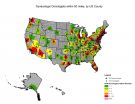Nearly 10 percent of women live too far from access to gynecologic cancer care
Findings reveal gaps in specialty care for ovarian, uterine and cervical cancer throughout United States
2015-06-11
(Press-News.org) PHILADELPHIA -- More than one-third of counties in the Unites States are located more than 50 miles from the nearest gynecologic oncologist, making access to specialty care for ovarian and other gynecologic cancers difficult for nearly 15 million women. While most of these "low access" counties are located in the Mountain-West and Midwest regions, the findings of a recent study from researchers at the Perelman School of Medicine at the University of Pennsylvania also reveal that 47 states have at least one county located more than 50 miles from the nearest gynecologic oncologist. Results of the study appeared online in the journal Gynecologic Oncology.
"This is the first national study to identify specific regions of the United States where residents may be at an increased risk for poor clinical outcomes - including misdiagnoses and late detection - as a result of limited access to specialized gynecologic cancer care," says David Shalowitz, MD, a fellow in the division of Gynecologic Oncology at the Perelman School of Medicine at the University of Pennsylvania, and lead author on the study. "Based on our estimates, it's likely that more than 7,000 women with gynecologic cancers per year experience distance-related barriers to accessing appropriate care from a specialist. Increased travel time to a specialty center likely prevents many patients from being appropriately evaluated, and may decrease their likelihood of receiving the standard of care, or accessing clinical trials for ovarian, uterine and cervical cancers."
Using spatial analysis, the authors determined how many gynecologic oncologists were located within 50, 100, and 150 miles of county borders for more than 3,000 counties in the United States. Thirty-six percent of counties were located more than 50 miles from the closest gynecologic oncologist, affecting 14.8 million women. Results reveal that all states except North Dakota and Wyoming contain a primary professional address for at least one gynecologic oncologist, though all states but three have at least one county further than 50 miles from the closest specialty care center. Further, the entirety of the state of North Dakota is located more than 50 miles from the nearest primary address of these providers. The counties with the greatest number of gynecologic oncologists within 50 miles are located near major metropolitan areas, primarily along the Atlantic coast between Atlanta and Boston.
Additional results of the analysis reveal that 15 percent of women may also experience barriers to care based on their referral network. The study showed 123 referral networks nationally that do not have access to a gynecologic oncologist, suggesting women would have to travel outside of their referral network to be connected with a specialist.
"Nine to 15 percent of women live in areas that likely limit their access to high-quality care for these potentially deadly conditions," said Shalowitz. "While we don't yet know how access correlates to health outcomes, referral networks need to be structured in a way that alleviates the burden of travel for women in need of a specialist."
In 2011, 20,797 cases of ovarian cancer, 47,824 cases of uterine cancer, and 12,187 cases of cervical cancer were reported nationally. Shalowitz and colleagues suggest future studies should focus on defining areas with poor clinical outcomes attributed to geographic factors, and creating a comprehensive national, geographically-linked database on the utilization of gynecologic cancer care and clinical outcomes.
INFORMATION:
Penn Medicine is one of the world's leading academic medical centers, dedicated to the related missions of medical education, biomedical research, and excellence in patient care. Penn Medicine consists of the Raymond and Ruth Perelman School of Medicine at the University of Pennsylvania (founded in 1765 as the nation's first medical school) and the University of Pennsylvania Health System, which together form a $4.9 billion enterprise.
The Perelman School of Medicine has been ranked among the top five medical schools in the United States for the past 17 years, according to U.S. News & World Report's survey of research-oriented medical schools. The School is consistently among the nation's top recipients of funding from the National Institutes of Health, with $409 million awarded in the 2014 fiscal year.
The University of Pennsylvania Health System's patient care facilities include: The Hospital of the University of Pennsylvania -- recognized as one of the nation's top "Honor Roll" hospitals by U.S. News & World Report; Penn Presbyterian Medical Center; Chester County Hospital; Penn Wissahickon Hospice; and Pennsylvania Hospital -- the nation's first hospital, founded in 1751. Additional affiliated inpatient care facilities and services throughout the Philadelphia region include Chestnut Hill Hospital and Good Shepherd Penn Partners, a partnership between Good Shepherd Rehabilitation Network and Penn Medicine.
Penn Medicine is committed to improving lives and health through a variety of community-based programs and activities. In fiscal year 2014, Penn Medicine provided $771 million to benefit our community.
[Attachments] See images for this press release:

ELSE PRESS RELEASES FROM THIS DATE:
2015-06-11
PHILADELPHIA - According to a new study, women experiencing difficulty with time management, attention, organization, memory, and problem solving - often referred to as executive functions - related to menopause may find improvement with a drug already being used to treat attention deficit hyperactivity disorder (ADHD). The study led by researchers at the Perelman School of Medicine at the University of Pennsylvania is the first to show that lisdexamfetamine (LDX) improved subjective and objective measures of cognitive decline commonly experienced in menopausal women. Results ...
2015-06-11
Researchers from Boston Children's Hospital and Merck have built the beginnings of "digital phenotype" of insomnia and other sleep disorders based on data from Twitter. This study, published today in the Journal of Medical Internet Research, is one of the first to look at relationships between social media use and sleep issues, and--based on assessments the sentiments expressed in users' tweets--gives preliminary hints that patients with sleep disorders may be a greater risk of psychosocial issues.
The study--led by Jared Hawkins, PhD; David McIver, PhD; and John Brownstein, ...
2015-06-11
Philadelphia, PA - "The impact of human mobility on disease dynamics has been the focus of mathematical epidemiology for many years, especially since the 2002-03 SARS outbreak, which showed that an infectious agent can spread across the globe very rapidly via transportation networks," says mathematician Gergely Röst. Röst is co-author of a paper to be published this week in the SIAM Journal on Applied Dynamical Systems that presents a mathematical model to study the effects of individual movement on infectious disease spread.
"More recently, the risk of polio ...
2015-06-11
Washington D.C., June 11, 2015 - A study published in the June 2015 issue of the Journal of the American Academy of Child and Adolescent Psychiatry demonstrates that the atypical trajectory of cortical/brain development in autism spectrum disorder (ASD) extends well beyond young childhood and into late adolescence and young adulthood.
A considerable amount of work has focused on early structural brain development in ASD utilizing magnetic resonance imaging (MRI). This body of work has revealed evidence for brain overgrowth during the early postnatal years that appears ...
2015-06-11
CAMBRIDGE, Mass--An MIT team has developed a way of making soft materials, using a 3-D printer, with surface textures that can then be modified at will to be perfectly smooth, or ridged or bumpy, or even to have complex patterns that could be used to guide fluids.
The process, developed using detailed computer simulations, involves a material that is composed of two different polymers with different degrees of stiffness: More rigid particles are embedded within a matrix of a more flexible polymer. When squeezed, the material's surface changes from smooth to a pattern ...
2015-06-11
June 11, 2015 - The well-known "fight or flight" response is part of the inborn series of defense/fear responses activated in reaction to threats. Understanding the steps of the defense cascade can help in forming effective treatments for patients dealing with persistent aftereffects of trauma, according to a review in the Harvard Review of Psychiatry. The journal is published by Wolters Kluwer.
Child and adolescent psychiatrist Kasia Kozlowska of The Children's Hospital at Westmead, Australia, and colleagues explain the five steps of the defense cascade, in a framework ...
2015-06-11
In a study that seems to defy conventional dietary wisdom, University of Iowa scientists have found that adding high salt to a high-fat diet actually prevents weight gain in mice.
As exciting as this may sound to fast food lovers, the researchers caution that very high levels of dietary salt are associated with increased risk for cardiovascular disease in humans. Rather than suggest that a high salt diet is suddenly a good thing, the researchers say these findings really point to the profound effect non-caloric dietary nutrients can have on energy balance and weight gain.
"People ...
2015-06-11
This news release is available in German.
Small heat shock proteins ensure that other proteins do not clot, allowing the cell to survive stress. Defects in these "small helpers" are associated with medical conditions like cataracts and cancer. Now, scientists at the Technische Universität München (TUM) have characterized a small heat shock protein responsible for embryonic development in the Caenorhabditis elegans nematode. Presumably, a similar protein exists also in humans.
Like humans, cells often face catastrophic situations. Even though cells are ...
2015-06-11
PETALUMA, California--A recent study published in the journal Conservation Biology makes a strong case for a new approach to conservation planning that uses much more robust data sets in order to better protect birds, plants, and animals.
The concept is fairly simple, but won't work unless scientists can agree to share data across studies.
"Right now, we primarily only use presence and absence data for species when conservation planning for large landscapes. Much of this is due to the cost and time of collecting more comprehensive data," said the study's lead author, ...
2015-06-11
Cuckoo finches in Africa have adopted a unique disguise to help them lay their eggs in other birds' nests, biologists have found.
The cuckoo finch in Zambia has evolved to be almost indistinguishable from common and harmless female weaver birds, such as the southern red bishop, said Dr William Feeney, from The Australian National University (ANU).
"The cuckoo finch is so similar to the innocent bishops, that the target of the trickery, the tawny-flanked prinia, cannot tell them apart," said Dr Feeney, who did his PhD at the ANU Research School of Biology before taking ...
LAST 30 PRESS RELEASES:
[Press-News.org] Nearly 10 percent of women live too far from access to gynecologic cancer care
Findings reveal gaps in specialty care for ovarian, uterine and cervical cancer throughout United States


